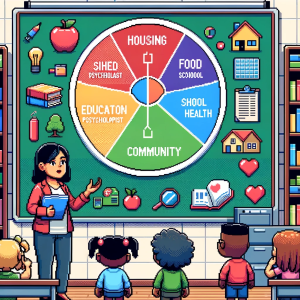
How School 911 Calls Reveal a Crisis in Student Mental Health
Imagine this: it’s a regular school day, just past noon, and the cafeteria is buzzing with the usual lunchtime commotion. But amidst the noise, a student sits in the corner, visibly distressed, their hands shaking. A concerned staff member approaches, but things quickly escalate, leading to a 911 call for emergency assistance. In that moment, the school is not just dealing with a student having a bad day—they are confronting a mental health crisis that underscores a larger problem.
This scenario is more common than many realize. A new study analyzing over 12,000 emergency calls from Boston public schools between 2014 and 2018 reveals a troubling pattern: schools are increasingly relying on 911 to manage both psychiatric crises and physical altercations, with serious implications for student well-being.
The Data Behind the Calls
Researchers examined 911 calls made from Boston public school addresses over four school years, and the findings are alarming. While the overall volume of calls increased each year, much of this rise came from hang-ups and abandoned calls. Yet, what truly stands out are the patterns in calls coded as “Emotionally Disturbed Person” (EDP)—a term used when the primary reason for the call is a psychiatric crisis. About 7.4% of the calls fell into this category, while another 6.5% involved physical assaults or fights.
The data also reveals critical timing trends. The majority of these calls occurred in the middle of the school day, peaking around noon. EDP calls tended to happen earlier in the day, while physical fights persisted later into the afternoon. There was also a clear seasonal trend, with call volumes increasing in late spring, a time when students may feel heightened stress due to academic pressures and impending summer break.
These findings paint a stark picture of how schools—despite their best intentions—may be ill-equipped to address the complex mental health needs of their students without resorting to emergency services.
Schools in Crisis Mode: What This Means for Students
For many students, schools are a second home, where they should feel safe and supported. But when psychiatric crises or physical conflicts arise, calling the police may not be the best or safest solution. The use of 911 in such situations highlights a deeper issue: the lack of adequate mental health resources available within schools.
It’s important to consider what happens after a 911 call is made. While the immediate crisis may be de-escalated, the involvement of law enforcement in schools can have long-term consequences, especially for students of color. Research shows that these students are more likely to experience negative interactions with police, which can lead to a cycle of criminalization and exacerbate mental health struggles.
Furthermore, when police are called to handle a psychiatric emergency, it often diverts them from other duties. According to national data, mental health-related calls consume significantly more time than other 911 calls, such as traffic incidents or minor disturbances. On average, resolving a mental health call can take nearly an hour—time that could be spent elsewhere if schools had the resources to handle such crises internally. (and really, this is whole point of 988!)
What Schools Need: A Shift in Resources
The reliance on emergency services to manage student mental health crises signals a critical gap in school-based mental health support. While some schools have partnerships with community mental health organizations, this study suggests that these resources are either insufficient or underutilized.
What’s clear is that schools need a more proactive, preventative approach to mental health. By the time a 911 call is made, it’s often too late—the crisis is already unfolding. Imagine if schools had mental health professionals on hand to intervene before things escalated. These professionals could provide students with ongoing support, helping them navigate their emotional struggles before they reach a breaking point.
Furthermore, the study highlights the importance of timing. Schools might benefit from increased mental health staffing during the middle of the day, particularly around lunchtime and recess when unstructured activities can lead to heightened stress and conflict. Additionally, increasing support toward the end of the school year, when call volumes peak, could help prevent crises from occurring during these high-stress periods.
Real-World Impact: How Parents and Educators Can Respond
For parents, this research is a wake-up call. It’s a reminder that mental health struggles don’t just happen at home—they happen in the places where children spend most of their time: at school. If your child seems particularly stressed or anxious, consider reaching out to their teachers or school counselors. Proactive communication can ensure that schools are aware of potential issues before they become emergencies.
School mental health professionals, on the other hand, are in a unique position to advocate for systemic change. This data shows the need for better integration of mental health services within the school environment. Schools should not rely on police intervention to handle psychiatric crises when trained mental health professionals can provide more appropriate and compassionate care.
The Path Forward: Creating Safer, Healthier Schools
The data from Boston’s schools is not unique; it’s a reflection of a national issue. Schools across the country are grappling with how to manage student mental health in an era of increasing anxiety, depression, and stress among young people. However, relying on emergency services as the default response is not sustainable.
What’s needed is a concerted effort to invest in school-based mental health resources. Imagine a school where students in crisis could immediately turn to a counselor or therapist for help, where teachers were trained to recognize the early signs of emotional distress, and where parents were regularly engaged in conversations about their children’s mental well-being. These are the kinds of schools that can prevent crises, rather than simply reacting to them.
The Boston study offers a roadmap for change. By understanding when and why schools call 911, we can start reallocating resources to better support students. Whether it’s increasing mental health staffing during critical times of the day or providing additional training for teachers, the goal is the same: to create schools that are not just places of learning but places of healing.
Conclusion: What Can We Do Next?
This research makes it clear that schools need more support in addressing student mental health crises. But how do we move forward? Should schools invest in more mental health professionals or find other ways to handle psychiatric crises without involving the police? And as parents and educators, how can we ensure that our children are getting the mental health support they need in schools?
Step into the Future of School Psychology!
Engage with the dynamic field of educational mental health for only $5 monthly. This Week in School Psychology offers you a gateway to understanding and applying crucial psychological findings. Enjoy concise, powerful updates that make a difference. Subscribe and join a community dedicated to knowledge and impact. Take advantage of our special yearly rate and lead the way in educational innovation!



